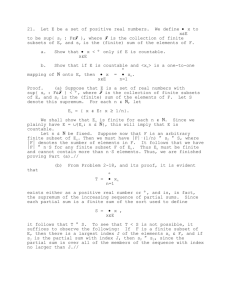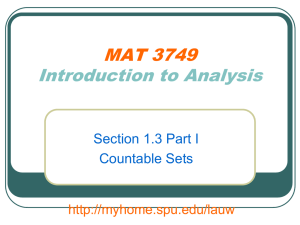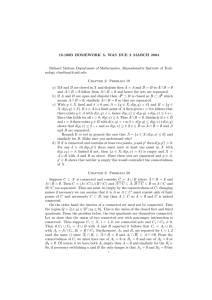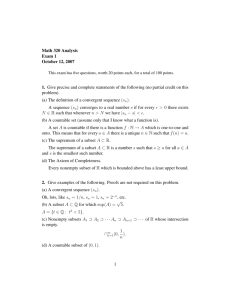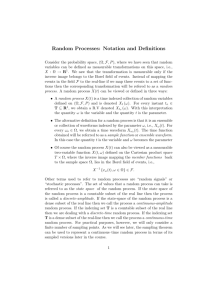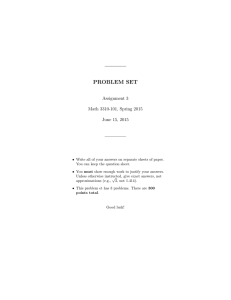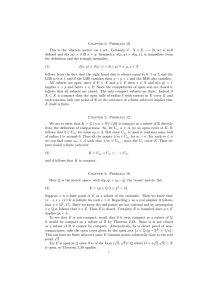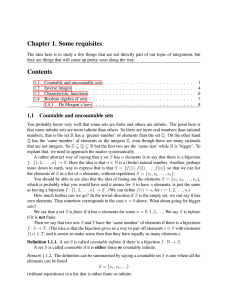B ANASTASE
advertisement
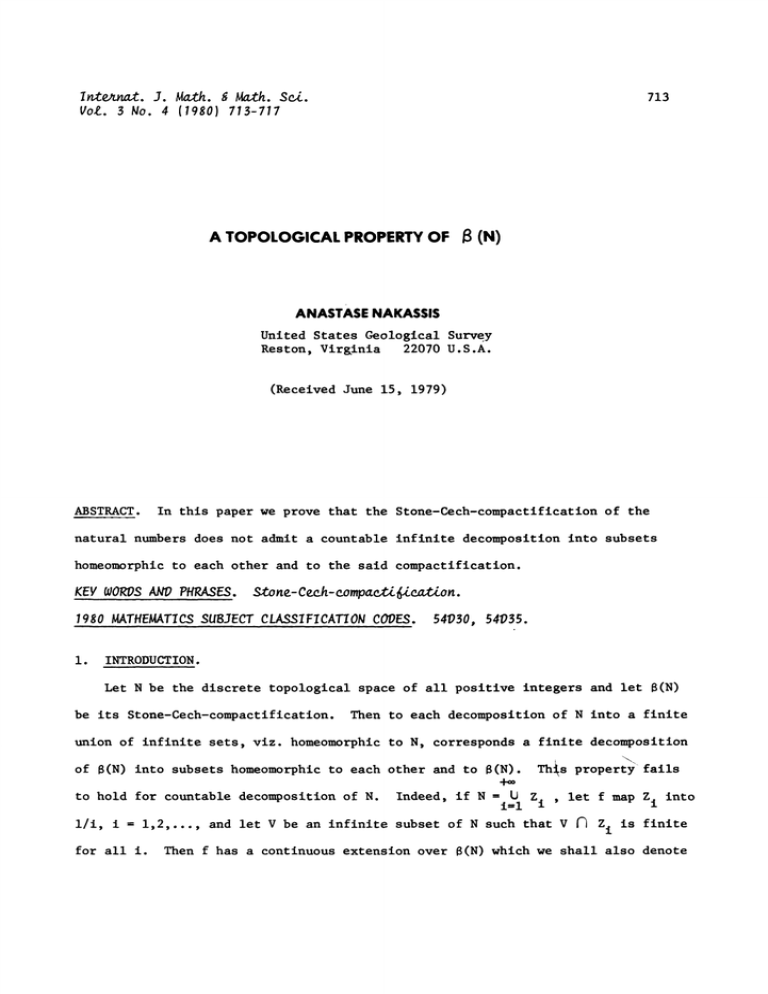
I ntat. J. Math. Math. Si.
Vol. 3 No. 4 (1980) 713-717
713
A TOPOLOGICAL PROPERTY OF
B (N)
ANASTASE NAKASSIS
United States Geological Surve,y
Reston, Virginia 22070 U.S.A.
(Received June 15, 1979)
In this paper we prove that the Stone-Cech-compactlflcatlon of the
ABSTRACT.
natural numbers does not admit a countable infinite decomposition into subsets
homeomorphic to each other and to the said compactlfication.
KEY WORDS AND PHRASES. Stone-Ceh-ompaifiaion.
1980 MATHEMATICS SUBJECT CLASSIFICATION CODES.
i.
54D30, 54D35.
INTRODUCTION.
Let N be the discrete topological space of all positive integers and let B(N)
be its Stone-Cech-compactlflcatlon.
Then to each decomposition of N into a finite
union of infinite sets, viz. homeomorphic to
N, corresponds a finite decomposition
of B(N) into subsets homeomorphic to each other and to (N).
to hold for countable decomposition of N.
i/i,
i
Indeed, if N
Ths propertY fails
=i=l Zi
1,2,..., and let V be an infinite subset of N such that V
for all i.
let f map Z
Z
i
i
into
is finite
Then f has a continuous extension over 6(N) which we shall also denote
714
A. NAKASSIS
by f and the following hold
a.
is compact but V is
since
b.
f maps V- onto O.
c.
V-V is not a subset of
%.Z i
not.
because f maps Z i
onto 1/i, i=1,2,...
Nevertheless, it is impossible that
(N)
might have some other
countable decomposition into subsets homeomorphic to each other and
to
(N).
Indeed, an assertion that this is the case, wrong as we
will prove below, appears as an exercise in Dugundji’s
OPOIOgy
(Exercise 9, page 256, Chapter XI, Eleventh Printing).
2.
REbULTS.
In this section we will prove that the assumption that (N)
admits a countable decomposition into subspaces homeomorphic to
is self-contradictory.
e suppose therefore that
that this union is disjoint and that all
of
@(N).
kJ U
discrete subspaces
Under this assumption me will prove that N intersects
infinitely many
.
U.’s are
(N)
(N)
Ui’s
and that it is contained in their union.
Then,
N and we will
the least element of
i
prove that the set thus formed has a closure that is not a subset
we will pick from each U
of
U i.
That, of
course,
Ui
ill be a contradiction.
have then
LEYIA I.
POUF.
LEMA 2.
not void.
For every subset T of N and every subset A of
(N),
T is open in N (N is discrete) and N is IocaIIy compact.
There are infinitely many i’s such that
UifN
is
TOPOLOGICAL PROPERTY OF 8(N)
PROOF.
8y the previous remarks
N is the union of the
(UiN)’s.
If
715
Oi(%N,
Uil% N
uir N
@
and therefore
for i
k+l, k+2,...,
then
(2)
and this is impossible.
Hence the lemma.
On the basis of this lea,a, -e can consider the family
[Ui
i
1,2,3,...
.
as the union of two families,
The first is infinite countable and contains all U
intersect
e
shall refer to it in the future as
s which
i
j
The second may be void, finite or infinite countable and contains all
Ui’s
which do not intersect N.
Let
Zi
Vif
We shall refer to it as
N, I=I,2,3,...
(3)
and let A be the set formsd by picking the least element of each Z
Then we can construct
.
family
{M(t)
t is a real
elements are infinite subsets of A and satisfy,
(s((t)
number]
if s
-hose
t, then
is void or finite.
One-ay to construct such a family is to enumerate the set of
all rationals Q, Q
sequence
rn(k, t
r
N,
n
to choose for each real t a
n
k=l which converges to t and has infinitely many
terms different from t, and to put,
Then,
For every t, M(t)
LEmIA 3.
PROOF.
l(t)
M(t)
is not.
For every t, Y(t) is an open subset of
LEM[?,A 4.
PROOF.
is compact and
E
l(t)k)h-l-TE
@(N).
and the union is disjoint.
xtend
i
A. NAKASSIS
716
N a function that is 0 on
continuously over
(t)l’i(t’)
PROOF.
(--)-)
is finite and
(t’)
and I on
3
N-;(t
(6)
(t)((t’).
is open in
@(N)
mhich
Therefore,
is Hausdor ff.
By the
t’.
If t
LEPTA 5.
then
(t)
I(t)(m(t’)
M(t)m(t’).
same token, (M(t) is open and r(t)((t’)
U(t)
and
ro
LEmA 6.
every t,
=
is finite)
.
()
(o)
P(t).
d(t)
#
Let f be a function which maps Z i onto I/i. If x is in
O. On the other hand, f(Z.)
I/i. Hence
M(t), then f(x)
PROOF.
M(t)
the lemma.
every
For
LEMA 7.
t, U(t) is an open-closed set in P and for
t 7( t’
every t and t’
u()nu(t’)
PROOF.
(t)
That
U(t)
and Lemma 4.
the fact that
M(t}
is open-closed foIloms from the construction of
U(t)U(t’)
That
and
M(t’) are
is a
follows from Lemma 5, end
subsets of N.
set and
’s
J is a countable
j
is an uncountable set of pairwise disjoint sets, there
Since the union of all
U(t)
.
t_
V’s and
t’ such that U(t’) does not meet any V j ’s or
a point in
LE|(IA
PROOF.
U(t’).
U(t’).
8.
j
’s.
Let x be
Then,
x does not belong to V j, j=1,2,3,...
x does not belong o Z. by the very construction of
On the other hand,
Indeed, me remark that:
Vj
Zj
is a subset of
(h)
-..,LJZi.
TOPOLOGICAL PROPERTY OF (N)
The V .’s have the discrete topology and
J
(vj
and
(,b)
If k
,
(vj
zj)Clzj
j, then
zj)n Zk- Vjn Vk
(vj
If every neighborhood of x in
would meet it.
zj)Czj
#
(12)
j
.
(N)
(13)
met
Vj- Zj,
then
U(t’)
5inca this is not the case, then x is not in V
j
-Zj.
Hence the lemma.
LEA g.
PROOF.
x does not belong to
j
is a subset of P.
j=1,2,3,...
If x were in
U(t’) would meet
hood of x, and in particular
t he
j,
every neighbor-
But this is not
CaS e.
As a result of Lemmas 8 and 9, me see that
a non-empty subset of
with
j,
j.
(N).
(N),
U(t’), by
construction
does not have any element in common
Therefore, our supposition was false.
REFERENCES
1.
Dugundji, James.
2.
Kuratowski, C.
3.
Nagata, Jun-iti.
To_o!ogy, Allyn
Toplogie
and Bacon, Inc.,
Boston, 1976.
I at_l!, arsaw, 1948, 1950.
loderq Genera’l T.p_olo_y, North-Holland
Publishing Company, Amsterdam, 1968.


